Aside: Now I am going to read to you this wonderful book Pete's a Pizza by William Steig. I especially like this story because it introduces narrative skills, which is the ability to retell a story.Read the story. Aside: You can use things from all around the house to tell a story, just as they used things from around the house in this story. Having your child retell stories helps to develop your child's own narrative skills for later life while at the same time increaseing his memory and imagination and love for books. Submitted by Miss Yolanda, Washington County (VA) Public Library
Tacky the Penguin by Helen Lester

Submitted by David Banker, Radford (VA) Public Library
Maybe a Bear Ate It by Robie Harris
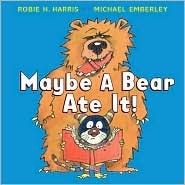
Submitted by Dawn Cheney, Glenvar Branch, Roanoke County (VA) Public Library
Snap! by Marcia Vaughan
 Read the book Snap! by Marcia Vaughan.Early Literacy Aside--Example: This book lends itself to retelling events which helps your child understand the story. Encourage your child with questons that leave room for them to describe what they hear or see. I used questions like, "What did Joey do when his Mom fell asleep?" and "Who did he meet?"
Early Literacy Aside--Empower: The ability to retell a story is an important skill for children to have in order to understand what they are reading. Predicting what happens next and acting it out, or as it's usually called, pretend playing, is a fun way to retell a story and to gain background knowldge along the way.
Read the book Snap! by Marcia Vaughan.Early Literacy Aside--Example: This book lends itself to retelling events which helps your child understand the story. Encourage your child with questons that leave room for them to describe what they hear or see. I used questions like, "What did Joey do when his Mom fell asleep?" and "Who did he meet?"
Early Literacy Aside--Empower: The ability to retell a story is an important skill for children to have in order to understand what they are reading. Predicting what happens next and acting it out, or as it's usually called, pretend playing, is a fun way to retell a story and to gain background knowldge along the way.
Submitted by Donna Hackman, Bedford (VA) Public Library and Justin Azevedo, Sacramento (CA) Public Library
The Aminal by Lorna Balian
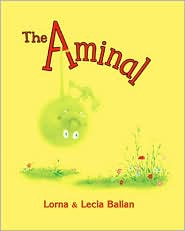
Submitted by Carolyn B. Morehead, Big Island Library, Bedford (VA) Public Library
Blue Goose by Nancy Tafuri
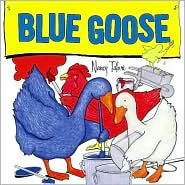
Jazzmatazz! by Stephanie Calmenson
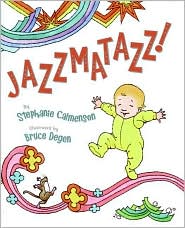
Help! A Story of Friendship by Holly Keller
 Early Literacy Aside--Explain: When you help your children pay attention to the print in books, you are helping to develop their print awareness, one of the early literacy skills that will later help them learn to read. I'll point out a couple of things in storytime today that will support this skill.
Read the story Help! A Story of Friendship by Holly Keller. [When you come to the page with the deep hole, you have to turn the book the long way.] Wow! This hole is so deep we have to turn the book around. Look the writing changed direction too!
Early Literacy Aside--Example: Children's attention often goes to the pictures. By pointing out the direction of print you help develop your children's print awareness.
Early Literacy Aside--Explain: When you help your children pay attention to the print in books, you are helping to develop their print awareness, one of the early literacy skills that will later help them learn to read. I'll point out a couple of things in storytime today that will support this skill.
Read the story Help! A Story of Friendship by Holly Keller. [When you come to the page with the deep hole, you have to turn the book the long way.] Wow! This hole is so deep we have to turn the book around. Look the writing changed direction too!
Early Literacy Aside--Example: Children's attention often goes to the pictures. By pointing out the direction of print you help develop your children's print awareness.
Thank You Bear by Greg Foley
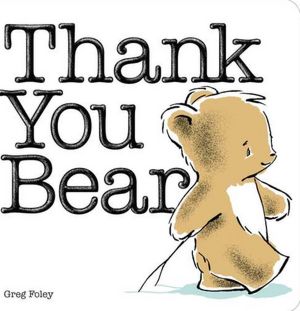
Talk about how what is special to one person might not be special to another. People see things and use things differently.Read the book Thank You Bear by Greg Foley. Activity: Pull out a cardboard box and have the children act out the story. You are the bear. There can be as many monkeys, owls, elephants, etc. as there are children who want to be that animal. Then talk together about the many things you can do with a box. Early LiteracyAside--Example: Acting out stories and having children say parts helps develop their narrative skills, the expressive part of language. Retelling stories is one way that children will later more easily understand what they read. If your child did not get a chance to talk about how they might use a box, listen to their ideas on the way home.
Early Literacy Aside--Empower: Here is a handout for making stick puppets. Using props or puppets is one fun way to encourage children to retell stories at home. It is activities like this that you do with your children that set them on a strong road to reading, in this case helping them understand what they read and how stories work! Puppets: Patterns for making stick puppets. The pattern for the mouse is here, but I use a mouse puppet. The pattern for a bear is also here, but I make myself the bear when I am retelling it with these stick puppets. Thank You Bear stick puppets
Where the Wild Things Are by Maurice Sendak
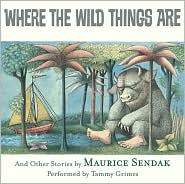
Recess Queen by Alexis O'Neill
 Early Literacy Aside--Explain: One thing you can pass on to your children is an enjoyment of books. Children who enter school enjoying books and reading are more likely to stick with learning to read even if it is difficult. For over half our children, learning to read in school is difficult. I know we have a lot of book-lovers here. In today's storytime, I'll point out some ways to keep your children's attention and keep the booksharing time enjoyable.Book Introduction: I show the cover of the book Recess Queen by Alexis O'Neill and flip through the pages to show my love of a few descriptive illustrations, especially facial expressions that show feelings like”mad and scared.
Early Literacy Aside--Example: Read with your child in a comfortable setting so you may share and talk about the book, including what the pictures are saying. When you take time to talk with your child and listen to what your chld says about the pictures, you are helping to make an enjoyable time with the book, which helps print motivation.
Early Literacy Aside--Explain: One thing you can pass on to your children is an enjoyment of books. Children who enter school enjoying books and reading are more likely to stick with learning to read even if it is difficult. For over half our children, learning to read in school is difficult. I know we have a lot of book-lovers here. In today's storytime, I'll point out some ways to keep your children's attention and keep the booksharing time enjoyable.Book Introduction: I show the cover of the book Recess Queen by Alexis O'Neill and flip through the pages to show my love of a few descriptive illustrations, especially facial expressions that show feelings like”mad and scared.
Early Literacy Aside--Example: Read with your child in a comfortable setting so you may share and talk about the book, including what the pictures are saying. When you take time to talk with your child and listen to what your chld says about the pictures, you are helping to make an enjoyable time with the book, which helps print motivation.
Submitted by Carolyn Lewis, Pamunkey (VA) Regional Library
Who Took the Farmer's Hat? by Joan Nodset
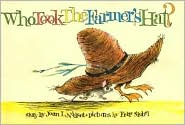
Submitted by Linda Gosnell, Pamunkey (VA) Regional Library
Little Red Hen
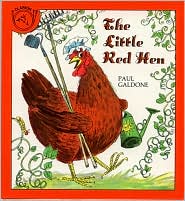
Submitted by Phyllis Arbogast, Blackwater (VA) Regional Library, Carrollton Branch
Is Your Mama a Llama? by Deborah Guarino
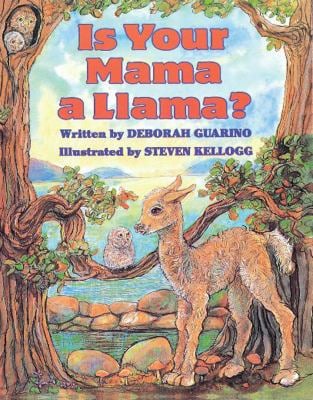 Early Literacy Aside--Explain:The ability to hear and play with the sounds of words, as in rhyming, is an important skill for reading. To recognize these rhymes and how words are related by sound is part of what educators term phonological awareness and will help your children later sound out words.During the storytime, read the book Is Your Mama a Llama? by Deborah Guarino
Each page describes the animal that might be llama's mother. Let's guess what will come on the next page. I will emphasize the word that will rhyme on the next page. For example, if I say now, guess what animal we will see. The author gives us other clues, like brown and moo. So, we know the animal will rhyme with now is COW!
Early Literacy Aside--Example: Some books, like this one, use rhymes in a playful way. Playing with rhyming words is one good way to help children hear the smaller sounds in words which will later help them sound out words when they learn to read.
Early Literacy Aside--Explain:The ability to hear and play with the sounds of words, as in rhyming, is an important skill for reading. To recognize these rhymes and how words are related by sound is part of what educators term phonological awareness and will help your children later sound out words.During the storytime, read the book Is Your Mama a Llama? by Deborah Guarino
Each page describes the animal that might be llama's mother. Let's guess what will come on the next page. I will emphasize the word that will rhyme on the next page. For example, if I say now, guess what animal we will see. The author gives us other clues, like brown and moo. So, we know the animal will rhyme with now is COW!
Early Literacy Aside--Example: Some books, like this one, use rhymes in a playful way. Playing with rhyming words is one good way to help children hear the smaller sounds in words which will later help them sound out words when they learn to read.
Maisy Big, Maisy Small by Lucy Cousins

Submitted by Ellen Abramson, Fairfax County (VA) Public Library System
Let's Go Froggy by Jonathan London

Submitted by Charles Nagel, Chesterfield County (VA) Libraries
Little Bunny Foo Foo: Told and Sung by the Good Fairy by Paul Johnson
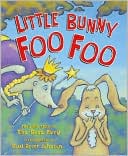
Submitted by Jackie Anas, Portsmouth (VA) Public Library
A Good Day by Kevin Henkes
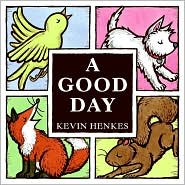
Train Goes Clickety-Clack by Jonathan London

Little Red Hen

ReadTheLittle Red Hen. As your read the repeated phrases, "Not I," said the dog;"Not I," said the cat; "Not I," said the mouse, run your finger under those words as you say them.
Early Literacy Aside--Example: Running your finger under some of the words helps your child understand that it is the words you are reading, not the pictures. Researchers have found that even for four year olds, 95% of their attention is on the pictures. By pointing you help draw their attention to the text. This helps develop print awareness.
